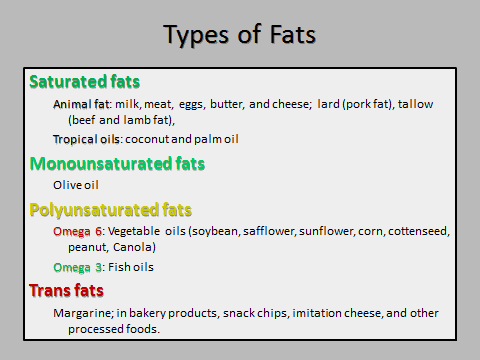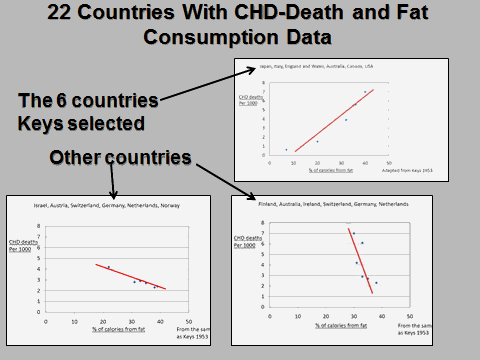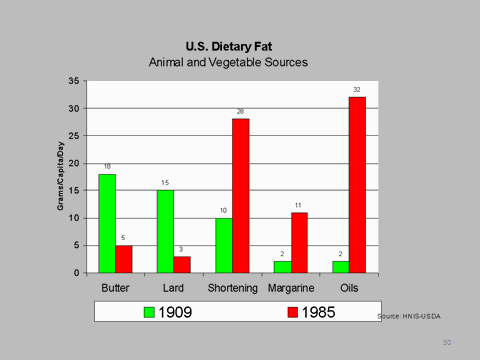lewrockwell.com Retrieved from: http://archive.lewrockwell.com/miller/miller38.1.html
Types and Structure of Fats
Animals and tropical plants contain saturated fats while plants outside the tropics have mostly unsaturated fats. Saturated animal fats are in milk, meat, eggs, butter, and cheese. And tropical coconut and palm oil contain a lot of saturated fat.
The food industry makes trans fats. They do this by shooting hydrogen atoms into polyunsaturated vegetable oils. This straightens out the fatty acid molecules and packs them closer together, giving vegetable oil so treated a solid texture like lard. Trans fats are used to make margarine, with yellow bleach added so it looks like butter. They are also used prolong the shelf life of bakery products, snack chips, imitation cheese, and other processed foods.
Crisco
A hundred years ago less than one in one hundred Americans were obese and coronary heart disease was unknown. Pneumonia, diarrhea and enteritis, and tuberculosis were the most common causes of death. Now, a century later, the two most common causes of death are coronary heart disease and cancer, which account for 75 percent of all deaths in this country. There were 500 cardiologists practicing in the U.S. in 1950. There are 30,000 of them now – a 60-fold increase for a population that has only doubled since 1950.
Take a look at the evidence for supporting the Lipid Hypothesis and then Evidence against it.
First,
Evidence Supporting the Lipid Hypothesis
Rabbits, Cholesterol, and Atherosclerosis
In 1913 a Russian physiologist fed high doses of cholesterol to rabbits and showed that cholesterol caused atherosclerotic changes in the rabbit’s arterial intima like that seen with human atherosclerosis. Over the ensuing decades other investigators did atherosclerosis research on cholesterol-fed rabbits, which they cited in support of the diet-cholesterol theory of heart disease.
Framingham Heart Study
In 1948, government-funded investigators began following some 5,000 men and women in Framingham, Massachusetts to see who developed coronary heart disease. They found that people with elevated cholesterol were more likely to be diagnosed with CHD and die from it.
Six years later the American Heart Association began promoting what it called the Prudent Diet, where "corn oil, margarine, chicken, and cold cereal replaced butter, lard, beef, and eggs."
Ancel Keys Six-Country and Seven-Country Studies
Ancel Keys, the father of K-rations for the military, published a study in 1953 that correlated deaths from heart disease with the percentage of calories from fat in the diet. He found that fat consumption was associated with an increased rate of death from heart disease in the six countries that he studied.
McGovern Report
The U.S. Senate Select Committee on Nutrition and Human Needs, chaired by Senator George McGovern, released, in 1977, its "Dietary Goals for the United States," designed to reduce fat intake and avoid cholesterol-rich foods. These dietary goals became become official government policy.
McDonalds and the Center for Science in the Public Interest
Next, in 1984 the Center for Science in the Public Interest, a consumer advocacy group, joined the fray and started to coerce fast-food restaurants and the food industry to stop baking and frying food with animal fats and tropical oils. McDonalds fried its French fries with beef fat and palm oil. That's why they tasted so good. But the Center for Science in the Public Interest’s well-orchestrated saturated fat attack coerced McDonalds and other fast-food chains to switch to partially hydrogenated, trans-fat vegetable oil.
Dietary Guidelines for Americans 2010
Beginning in 1980, the U.S. Department of Agriculture and Department of Health and Human Services has published every five years an updatedDietary Guidelines for Americans. The most recent one, published in December 2010, recommends reducing saturated fat intake to 7 percent of caloric intake, down from its previously recommended 10 percent.
Meet the Fats
Swedish Heart Institute, Seattle and Dean Ornish
Indoctrinated in low-fat dogma by health organizations, nutrition authorities, and the government, I would instruct my heart surgery patients to eat a low fat diet, telling them to cut all the fat off their meat and not eat more than one egg a week. And following the USDA food pyramid I did not express any concerns about how much carbohydrates they might consume, from starch in bread, pasta, rice, and potatoes and sugar in fruit, fruit juices, pastry, and sodas.
I was wrong. Several years later, after leaving Swedish and rejoining the faculty the University of Washington, I came upon an article by Dr. Mary Enig and Sally Fallon titled "The Oiling of America" that was published in the magazine Nexus in 1999. It stimulated me to look more carefully into this subject.
Sleeper
Oscar Wilde said "Life imitates art." He noted that "Life imitates art far more than art imitates life." In his film "Sleeper" Woody Allen plays Miles Monroe, part owner of the Happy Carrot Health Food Restaurant in Greenwich Village. He was cryogenically frozen in 1973 after a botched peptic ulcer operation done at the now closed St. Vincent's Hospital. Two hundred years later scientists wake him up and revive him.
In a scene from this movie the two scientists have this exchange. Dr. Aragon: "Has he asked for anything special?" Dr. Melik: "Yes. This morning for breakfast he requested something called wheat germ, organic honey, and tiger's milk." Dr. Aragon: "Oh yes. Those were the charmed substances that some years ago were felt to contain life-preserving properties." Dr. Melik: "You mean there was no deep fat? No steak or cream pies or hot fudge?" Dr. Aragon: "Those were thought to be unhealthy, precisely the opposite of what we now know to be true." Dr. Melik: "Incredible!" The YouTube title of this scene is Woody Allen's 1973 film "Sleeper" may accurately portray healthy eating in the future.
But if life does imitate art, what about all the evidence that shows saturated fats and cholesterol clog arteries and cause atherosclerosis?
Evidence Against the Lipid Hypothesis
Feeding Cholesterol to Omnivores Does Not Cause Atherosclerosis
Plants do not contain any cholesterol. Animals are the only source of cholesterol, and herbivores do not eat animal products. Rabbits, being a herbivore, are not designed to digest animal fat and cholesterol, so when it is fed high doses of cholesterol one should not be surprised if the cholesterol winds up getting stuck in any part of the poor rabbit, including its blood vessels. Feeding high doses of fat and cholesterol to omnivores, like rats and dogs, does not produce atherosclerotic lesions in them.
Other Countries with CHD-Death and Fat Consumption Data
Evidence against fat wilts upon close scrutiny. In his Six Country Study, Ancel Keys ignored data available from 16 other countries that did not fall in line with his desired graph. If he had chosen these six other countries [on the left side], or even more strikingly, these six countries [on the bottom right] he could have shown that increasing the percent of calories from fat in the diet reduces the number of deaths from coronary heart disease.
If Keys had included all 22 countries in his study, the result would have been a clutter of dots like this.
Diets in People with the Lowest Risk of Heart Disease – Masai, Inuit, Rendille, Todelau
The diet of the Maasai tribe in Kenya and northern Tanzania consists of meat, milk, and blood from cattle. It is 66 percent saturated fat.
The diet of Inuit Eskimos in the Artic, consisting largely of whale meat and blubber, is 75 percent saturated fat; and they live long healthy lives free of heart disease and cancer.
The Rendille tribe in the Kaisut Desert in NE Kenya subsist on camel milk and meat, and a mixture of camel milk and blood, known as "Banjo." Their diet is 63 percent saturated fat.
The Tokelau live well, without cardiologists, on three atoll islands that are now a territory of New Zealand. Their diet consists of fish and coconuts, which is 60 percent saturated fat.
The new social media of Facebook, Twitter, and YouTube is not only helping to overthrow dictators and autocratic regimes but also wrong medical dogmas. This one, titled "Big Fat Lies" exposes the chicanery Ancel Keys practiced in his work.
But what about the Framingham Study? In 1987, in the Journal of the American Medical Association Framingham Study investigators reported these two important findings: 1) Over age 50 there is no increased overall mortality with either high or low serum cholesterol levels, and 2) In people with a falling cholesterol level (over the first 14 years of the study), for each 1% mg/dl drop in cholesterol there was an 11 percent increase in all-cause mortality over the next 18 years. (JAMA1987;257:2176-2180)
Contrary Long-term Findings of the Framingham Heart Study
Then, in 1992, in the Archives of Internal Medicine, the third director of the study, Dr. William Castelli, reported: "In Framingham, Mass., the more saturated fat one ate, the more cholesterol one ate, the more calories one ate, the lower the person’s serum cholesterol" [emphasis in original]… We found that the people who ate the most cholesterol, ate the most saturated fat, ate the most calories, weighed the least, and were the most physically active." (Arch Int Med 1992;152:1271-2)
Most doctors have not heard about these findings because medical organizations, notably the American Heart Association, government agencies, and the pharmaceutical industry have ignored them. After all, prescribing statin drugs to lower cholesterol is a $25 billion/year industry.
The Politics Behind the McGovern Report
What about our government and the McGovern Report? The YouTube video titled "The McGovern Report" (shown at the meeting) deals with it in a pithy way.
Saturated Fat and Heart Disease
Evidence that the McGovern Committee did not have in the 1970s is this 2005 report of European Cardiovascular Disease Statistics.
Reasons Why Saturated Fats Are Good For Us
The Biologic Importance of Saturated Fat
There is good reason why 54 percent of the fat in mother’s milk is saturated fat. Cell membranes need saturated fatty acids to function properly and be "waterproof." The heart prefers saturated long-chain 16-carbon palmitic and 18-C stearic acid (over carbohydrates) for energy. Bones need them to assimilate calcium effectively. They protect the liver from the adverse effects of alcohol and medications like Tylenol. Lung surfactant is composed entirely of saturated 16-C palmitic acid, and when present in sufficient amounts prevents asthma and other breathing disorders. Saturated fats function as signaling messengers for hormone production.
Saturated fats signal satiety, so you stop eating because you feel full, lose fat, and maintain a normal weight.
And, importantly, eating saturated fats reduces consumption of health-damaging carbohydrates and polyunsaturated vegetable oils.
Cracks in the Wall of Diet-Cholesterol Heart Orthodoxy
The American Journal of Clinical Nutrition is a leading establishment medical journal that defends the lipid hypothesis. Even this journal has backed down and is now reporting cracks in the wall of diet-cholesterol-heart orthodoxy. A meta-analysis of prospective cohort studies evaluating the association of saturated fat with cardiovascular disease does not support the notion that saturated fats increase the risk of coronary heart disease, stroke, or peripheral vascular disease.
And this journal also recently published a prospective cohort study of 53,000 women and men comparing their intake of carbohydrates and saturated fats and found that replacement of saturated fats with high glycemic index carbohydrates significantly increases the risk of heart attacks.
This trial, published in the journal Lipids, enrolled 40 women with a waist circumference > 35 inches. Twenty were randomized to take 30 ml – two tablespoons – of coconut oil a day (Group C) over a 12-week period. The other 20 took 30 ml soybean oil/day (Group S).
The Group C women taking the coconut oil exhibited a significant reduction in waist circumference (for the statisticians among us the P value was 0.005) with no change in the soybean Group S. And the only thing that the saturated fat-laden coconut oil did to cholesterol levels was to raise HDL cholesterol, the one that advocates of the lipid hypothesis call the "good" cholesterol. (Lipids 2009;44:593-601)
Eat Fat Lose Fat
Dr. Mary Enig and Sally Fallon, president of the Weston Price Foundation, have written a book titled Eat Fat Lose Fat: Lose Weight and Feel Great with Three Delicious, Science-based Coconut Diets. I highly recommend it. The fat content of coconut oil is 92 percent saturated fat, the highest saturated fat content of any food. I now start each day with two tablespoons of coconut oil.
Other Considerations
Roles Cholesterol Play
What about cholesterol? As with saturated fat, it is not a villain. On the contrary, cholesterol is critical for good health. It is an essential component in every cell in the body. Although few doctors know this, more than 20 studies have shown that elderly people with a high cholesterol blood level live longer than do those who have a low cholesterol blood level.
Cholesterol also is the body’s fire brigade. It repairs damage to the body’s tissues, particularly the damage in arteries inflammation does to cause atherosclerosis. Blaming cholesterol for atherosclerosis is like blaming firemen for the fire they have come to put out.
Along with saturated fats, cholesterol is also an integral component of cell membranes.
The brain and nerve tissue contain the highest concentration of cholesterol in the body. It is a key component in forming synapses – cell connections – needed for good mental functioning, learning, and memory.
If not cholesterol, then what causes heart disease?
Atherosclerosis is an inflammatory process brought on by eating too many carbohydrates and omega-6 vegetable oils. Stress plays a role and possibly also bacterial infection.
A deficiency of various vitamins shown here may also play a role in causing atherosclerotic heart disease, as may an excess or deficiency of various minerals.
Over the past century, butter consumption has plummeted from 18 grams per person per day to 5 grams. Consumption of lard has dropped substantially while use of shortening has almost tripled. In 1909, shortening was a natural product made with coconut oil and lard. Shortening used today is made out of partially hydrogenated vegetable oil.
A good case can be made that these changes in fat-and-oil consumption over the last hundred years are the major cause of the epidemic of obesity, diabetes, heart disease, stroke, cancer, and learning disabilities in children. Observing the increasing use of vegetable oils during the 1940s and 1950s, a few physicians, notably Dr. Weston A. Price and Dr. Francis Pottenger, predicted that there would be increasing rates of such diseases.
Prevalence of Obesity among US adults 1950-2010
An epidemic of obesity has accompanied the adoption of a low-fat diet. With only 1 in 150 people obese when the century began, by 1950 nearly 10 percent of Americans were obese. Thirty years later, in 1980, it had risen to 15 percent. Then following publication of the U.S. Dietary Guidelines and its every-five-year updates, obesity in Americans has steadily risen. Now two-thirds of the American public is overweight, with more than one-third, obese. Today the average American weighs 30 pounds more that he or she did 100 years ago. American women weigh and average 167 pounds and men, 191 pounds.
Carbohydrate Consumption and Obesity
The rise in obesity parallels closely the rise in carbohydrate intake. As Gary Taubes shows in his book Why We Get Fat: and what to do about it, carbohydrates, not overeating or a sedentary life, are what make you fat. Eating fat and protein don’t make us fat, only carbohydrates do.
This graph, in Mark Sisson’s book The Primal Blueprint, compares carbohydrate intake with weight.
The Epidemic of Diabetes
Over a 30-year period from 1980-2008 the prevalence of diabetes more than tripled. Now, in 2011, according to the National Diabetes Fact Sheet, 25.8 million children and adults in the U.S., 8.3 percent of the population, have diabetes; and 79 million people, based on their fasting glucose and hemoglobin A1c levels, are prediabetic.
Diabesity
Diabetes and obesity go together, so much so that these disorders are now being called "diabesity". Body mass index (BMI) is the commonly used measure for obesity, calculated by dividing one’s weight in kilograms (Kg) by one’s height in meters squared (Kg/m2). One is considered to be obese if the BMI ≥30, and morbidly obese with a BMI of ≥35.
Disease Trends and Butter Consumption
Consumption of butter has dropped precipitously while cancer and heart disease has soared. The rise in cancer and heart disease certainly cannot be blamed on high-saturated-fat butter.
These books prove beyond a reasonable doubt that today’s chronic diseases, such as diabetes, heart disease, and cancer are nutritional diseases, a result of eating a low-fat (mainly polyunsaturated vegetable oil), high-carbohydrate diet. Alice and Fred Ottoboni wrote Modern Nutritional Diseases: heart disease, stroke, type-2 diabetes, obesity, cancer, and how to prevent them; Barry Groves, Trick and Treat: how healthy eating is making us ill; and Zoë Harcombe, The Obesity Epidemic: What caused it? How can we stop it?, Barry Groves, in particular, citing more than 1,000 references, documents how so-called "healthy" eating is making us ill.
Liquid Candy
A 12-ounce can of coke has ten teaspoons of sugar, which contain 42 grams of sugar, supplying 167 calories. A 20 ounce bottle has 17, and a 30 ounce bottle, 27 teaspoons of sugar. The average American drinks 600 cans (56 gallons) of soft drinks a year, up from 216 can in 1971. The average American teenager drinks 3 to 6 cans of soda a day!
In addition to Eat Fat, Lose Fat, I recommend two more books that can help us reduce our carbohydrate intake. One is Life Without Bread: how a low-carbohydrate diet can save your life. It describes diets that limit carbohydrate intake to 72 grams a day, which is equivalent to 6 slices of bread. The other one is Why We Get Fat: and what to do about it by Gary Taubes. Noting that meat, fish, and eggs contain no carbohydrates, he suggests that you can eat as much of them as you like, along with leafy green vegetables. (Try chicken salad wrapped in lettuce rather than as a sandwich between two slices of bread.)
The ideal caloric ratio between carbohydrates, fats, and protein is carbohydrates, 10-15 percent; proteins, 15-25 percent; and fats, 60-70 percent of calories, with the majority of them being saturated fats. Among the different kinds of fats, saturated fats and monounsaturated fats are good; except for omega-3 and a small amount of omega-6 essential fatty acids, polyunsaturated fats are bad in the high quantities that they are eaten in a Western diet, particularly industrially processed vegetable oils; and trans fats are terrible. Saturated animal fat is best obtained from grass-fed beef and pastured chickens, along with nitrate-free, additive-free bacon and sausage; and seafood from wild, not farm-raised, fish.
Confinement Butter vs. Grass-Fed Butter
Conclusion
Enjoy eating saturated fat but preferably from grass-fed animals.
The last word on this subject should go to Julia Child. It is on YouTube under the title, 1995 Clip: Julia Child on McDonald's French Fries.
http://lewrockwell.com/miller/miller38.1.html































